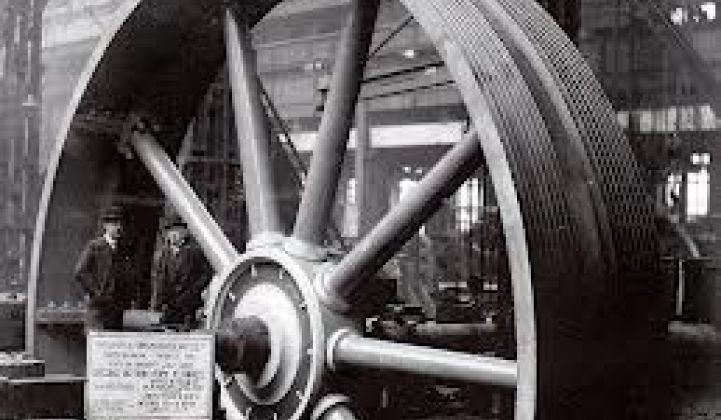If a startup wants to work with utilities, it helps to stick to domains in which utilities are comfortable.
“Utilities are very familiar with spinning steel,” said Cam Carver, CEO of Temporal Power, a Canadian startup with an all-steel flywheel technology.
The Ontario-based company is working with Hydro One to provide up to ten 500-kilowatt flywheels for frequency regulation on a feeder that is connected to two 10-megawatt wind farms in southwest Ontario.
Frequency regulation is the sweet spot for flywheel technology, which can quickly respond to the fluctuations on the grid to provide balancing services. Carver said that Temporal’s technology is ideal for providing about three minutes to fifteen minutes of storage.
Carver said that the 9,000-pound solid-steel device allows for higher performance without an overly large footprint, unlike some other flywheels that are made of carbon fiber. He also pointed to the company's permanent magnetic bearing systems as a difference compared to other competitors' technologies.
The result is that it can run for up to six minutes at its full rate of power and can store up to 50 times more energy. The flywheels can be scaled to provide anywhere from about 2 megawatts to 100 megawatts. “It’s bigger, simpler, more powerful -- and it’s cheaper,” said Carver. “We’re advancing it, but we’re also making it simpler.”
Hydro One is using 500-kilowatt units, which are under construction now. The flywheels can be matched with motors of various sizes, for a rated power mode of anywhere from 100 kilowatt-hours to 500 kilowatt-hours.
Competing for utilities’ attention in the storage market is difficult for any technology, but there is an added barrier for flywheels, given the bankruptcy of Beacon Power in 2011. Temporal Power works with Lockheed Martin on quality control and also leverages some of Lockheed’s expertise for safety and controls systems. “It’s treated like an airplane component,” Carver said of manufacturing and testing the technology.
The flywheel array for Hydro One will be providing millisecond-level responses to balance wind ramping beginning in 2014. The project is partially funded by Sustainable Development Technology Canada. After the pilot phase, Hydro One will own and operate the facility. Carver said that Temporal has no interest in operating storage parks, noting, “Our core competency is in building flywheels.”
Temporal Power has another project underway with Ontario Power Generation and NRStor, a startup that wants to develop an energy storage park in Canada. Temporal Power will deliver 2 megawatts of regulation service to the Independent Electricity System Operator (IESO) in Ontario.
Although frequency regulation is the most obvious use for flywheel technology, Temporal is also in talks with a mining company to provide frequency regulation and VAR control. The company is also looking at opportunities in Europe, which has some areas of high penetration of renewables, as well as the U.S., where FERC Order 755 calls for fast-responding sources to be paid more than slower sources.
Temporal Power has raised $13.5 million to date from Enbridge (NYSE:ENB) and Northwater Intellectual Property Fund.



